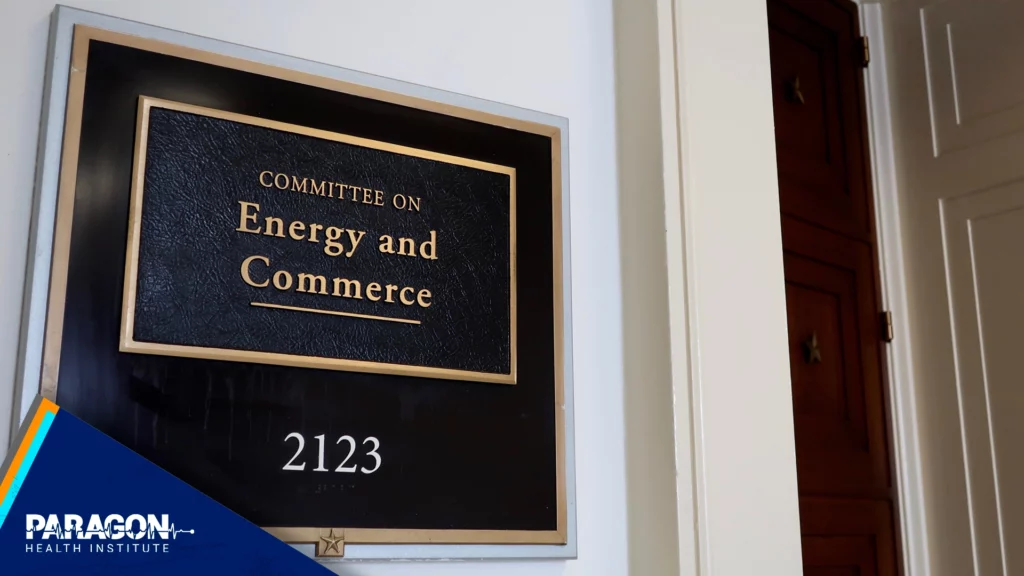Paragons’s President Brian Blase and Senior Policy Analyst Joe Albanese respond to the House Budget Committees’ request for information for their new congressional working group on solutions to reduce government improper payments.
Testimony of Joe Albanese before the House Committee on Energy and Commerce Subcommittee on Health
“What’s the Prognosis? Examining Medicare Proposals to Improve Patient Access to Care and Minimize Red Tape for Doctors”
October 19, 2023
Thank you, Chairman Guthrie and Ranking Member Eshoo, for the opportunity to testify before this subcommittee. My name is Joe Albanese, and I am a senior policy analyst at the Paragon Health Institute. We are a health policy think tank focused on empowering patients and reforming government programs. My testimony today represents my own views and not those of Paragon. In a previous hearing conducted by the Oversight and Investigations Subcommittee, I testified that the current physician payment framework under the Medicare Access and CHIP Reauthorization Act of 2015 (MACRA) helped to slow physician payment growth but failed to transition Medicare to “value-based care” and that lawmakers should reevaluate the government-driven approach to promoting value. Today, I intend to testify about how policymakers should balance the goals of minimizing costs for patients and taxpayers, maintaining access to physician services for Medicare beneficiaries, and improving Medicare pricing and payment policy. They can do this by:
- Offsetting increases in physician spending with other Part B savings;
- Pursuing market-based pricing of physician services in Medicare;
- Eliminating financial incentives for MIPS and advanced APM participation; and
- Enabling Medicare Advantage to remain a viable option for seniors.
I am grateful for this committee’s continued focus on these complex and important issues for seniors, as well as for the opportunity to share my views on them.
Background
Physician Payment Policy
Medicare’s policies have undergone multiple changes to balance the goals of cost efficiency, adequacy, and accuracy of physician payments. From its enactment to 1992, Medicare set prices based on doctors’ billed, customary, or prevailing charges for services.1 This resulted in significant expenditure growth. To control spending while adjusting payment levels with inflation, the Department of Health and Human Services tied increases in prevailing charges to the Medicare Economic Index (MEI), which tracks physician practice costs and earnings.2
When the MEI failed to control expenditures, Congress enacted a Physician Fee Schedule (PFS), which applies a resource-based relative value scale (RB-RVS) to a dollar conversion factor. The RBRVS estimates the cost for each service relative to others in terms of physician work, practice expenses, and liability insurance, adjusted by geographic differences in input costs. Fees were updated based on the MEI, adjusted by aggregate spending targets—the Volume Performance Standard starting in 1992, then the Sustainable Growth Formula (SGR) starting in 1999.
In 2003, Congress started overriding the payment cuts required by the SGR in what became known as the “doc fix.” By 2015, frustration with this nearly annual exercise and the large payment cuts that accumulated led Congress to replace the SGR with MACRA. MACRA set conversion factor updates in statute, including a freeze between 2020 and 2025 that resulted in effective cuts that Congress stepped in to reduce. Payment updates now come instead from either quality performance adjustments in the Merit-Based Incentive Payment System (MIPS) or bonuses for participating in advanced alternative payment models (APMs). The Affordable Care Act created one APM, the Medicare Shared Savings Program (MSSP), as well as the Center for Medicare and Medicaid Innovation (CMMI), a federal office that designs and manages its own APMs.3 MSSP offers accountable care organizations (ACOs) financial incentives to reduce costs and meet quality metrics.
Flaws in the Current Approach
Despite congressional intervention, the SGR and MACRA helped slow physician expenditures. The PFS conversion factor declined by roughly 8 percent between 1998 and 2023, and physician services fell from 48 percent to 32 percent of total fee-for-service (FFS) Part B spending, as other Part B services grew at a faster rate.4 However, the volume and intensity of physician services surged and PFS spending per aged FFS enrollee has risen by 128 percent since 1998 (versus a 66 percent growth in GDP, 88 percent in overall inflation, and 126 percent in medical inflation).5 This demonstrates that both the number and the per-unit cost of physician services are important factors in rising spending.
The slow growth in physician fees has raised concerns about Medicare beneficiaries’ access to care, as low pay may attract fewer doctors to participate. Medicare’s trustees and the Medicare Payment Advisory Commission (MedPAC) have cited this issue as a long-term concern, but it is not yet a significant problem. A MedPAC survey found that Medicare enrollees’ access to physician services is at least as good as that of privately insured people, even though employer-sponsored insurance pays higher rates.6 Figures 1 and 2 below show that access to physician services has been stable or improved in terms of doctors accepting new Medicare patients and overall participation rates.7 But preventing access problems may be preferable to responding after they have already emerged.
A long-standing concern across Medicare is the accuracy of its prices. The PFS, like other Medicare payment systems, relies on administrative price-setting. The Centers for Medicare and Medicaid Services (CMS) calculates the relative value of services in the RB-RVS based on estimates of resource needs with input from stakeholders. Research has found that the estimated amount of work needed for certain services does not match with real-world experience.8 Mispricing of services has concrete impacts in the health care sector. For example, overvaluation of specialist pay at the expense of primary care services has distorted labor supply, contributing to a shortage of primary care practitioners.9 Furthermore, FFS reimbursement incentivizes the provision of more health care services regardless of quality, leading to more wasteful or low-value spending.10 This allows providers to compensate for lower payment rates by performing more or costlier services.
One goal of MACRA was to hold physicians accountable for the value of care, but it has failed to do so. MIPS has increased clinician burden, its incentive structures are weak and easily gameable, and its quality measures are ineffective.11 APMs have also been disappointing. A recent report by the Congressional Budget Office (CBO) found that only six out of 49 CMMI models with published evaluations from 2011 to 2020 generated statistically significant savings, causing CBO to revisit its previously optimistic outlook on CMMI. Analysts have criticized CBO’s CMMI scoring assumptions for years.12 CBO’s old methodology estimated that CMMI would save $2.8 billion from 2011 to 2020 and $77.5 billion from 2021 to 2030, but it revised those figures to net losses of $5.4 and $1.3 billion, respectively. This does not account for the cost of advanced APM bonuses.13 The subset of advanced APMs have had a mixed record as well, often due to the size of incentive payments in the models. Of nine advanced APMs with published evaluations, only three reduced Medicare spending on net (see Appendix Table 1). Two of those—the Maryland Total Cost of Care model and the statutory MSSP—have multiple advanced and non-advanced tracks within them that do not have separate evaluations. Studies have also cast doubt on official MSSP savings numbers, as the results are based on spending targets that may not be accurate and that encourage selective entry and exit of participating ACOs.14
Discussion
Policy Goals
As policymakers consider revisiting Medicare’s physician payment policy, it should balance the goals of (1) controlling costs to patients and taxpayers, (2) maintaining long-term access to care for beneficiaries, and (3) addressing the distortions of FFS administrative pricing.
As noted above, access to physician services has increased for Medicare enrollees, but continued stagnation in physician payment rates could undermine access in the long run. Some have suggested tying PFS annual updates to the MEI or some percentage thereof to address inflation. Doing this would directly increase patient expenses, because Part B premiums are calculated based on program costs and coinsurance is a fixed percentage of allowable costs. Medicare beneficiaries already spend 28 percent of their Social Security checks on Part B and Part D expenses on average.
Of course, raising physician fees would also increase Medicare spending overall (as would extending advanced APM participation bonuses, as others have suggested). Part B is expected to account for two-thirds of Medicare spending growth in the next decade, and although there have been lower PFS updates, increases in the volume and intensity of such services still led to rising spending per enrollee. Unlike the Part A trust fund, which payroll taxes support, Part B’s trust fund is mostly financed by general revenues. The Medicare trustees project that this trust fund’s expenses will rise from 13 percent to 22 percent of all federal income tax revenue by 2030, directly crowding out other policy priorities and directly contributing to the national debt.15 Policy changes can worsen this outlook. All else being equal, if the PFS conversion factor had increased by the MEI from 1998 to 2023, Medicare spending would have been $550 billion higher over this period (see Figure 3 below).16 MedPAC found that updating PFS payment rates by just 50 percent of the MEI’s growth would increase spending by $5 billion to $10 billion over five years.17 It has also found and that extending advanced APM bonuses would cost $650 million per year.18
In terms of payment accuracy, policy experts have suggested various improvements to the PFS, such as providing more oversight over RB-RVS calculations, rebalancing pay among specialties, and other methodological changes.19 While some of these incremental changes might address identifiable shortcomings with the PFS’s current design, they would not fundamentally change Medicare’s FFS payment method or the inherent limitations of centralized, administrative pricing.
Previous policy actions have attempted to address this trade-off in various ways. Freezing payment updates, as under MACRA, is not sustainable in the long run. Aggregate spending targets such as the SGR were volatile and did not account for efficiencies among individual practices or specialties. Performance-based payments under MIPS have not improved quality. APMs that experimented with alternatives to FFS have largely failed to save money. What, then, should be policymakers’ approach?
Recommendations
First, Congress should avoid net increases to Medicare spending or average beneficiary costs by offsetting new physician spending with changes elsewhere in Part B. Along with rising interest payments on accumulated debt, federal health programs are the biggest driver of debt and must be reduced to avoid a fiscal crisis.20 Policy changes to Medicare should at minimum not add to this problem. There are numerous ways to achieve savings for Medicare without cutting benefits.21 For example, Medicare pays on average twice as much for outpatient services delivered in hospitals that could be performed in physicians’ offices. Establishing site-neutral payments would reduce this overspending, lower out-of-pocket costs for patients, and reduce incentives for hospital acquisition of independent physician practices.22 Part B drug spending has also increased rapidly, in part due to statutory requirements that Medicare pay 6 percent above the average sales price for drugs, even those that are acquired through discounts as in the federal 340B program. Congress could reduce these excess payments and give CMS the authority to pay more accurate rates for drugs. Neither of these examples would require major restructuring of Medicare’s payment systems.
Second, to allow for increases in physician pay without continuing to rely on government price-setting, lawmakers should adopt market-based pricing in Medicare FFS. Central planning and government price-setting are far less accurate determinants of economic value than are market prices, as the numerous distortions in Medicare payments show.23 Increasing payment rates by inflation would perpetuate the distortions in other Medicare payment systems without addressing existing inaccuracies in the PFS. A more direct way to determine the market value of health care services would be to base payment on the rates negotiated by Medicare Advantage (MA) plans. Such plans are required to cover Part A and B benefits at a minimum (and often provide more) to a similar beneficiary population and tend to have payment rates that are closer to Medicare FFS than other commercial payers are.24 Market pressures—such as contracting with providers, competing for enrollees, and maintaining profitability—incentivize them to maximize value in terms of higher quality health outcomes and lower costs.25 Although many private health plans currently base their reimbursement on Medicare FFS, negotiations with their provider networks would gradually cause them to deviate from it. This, coupled with price transparency rules, would push plans to reach market-bearing prices. If lawmakers instead choose to use an administrative measure of inflation to update PFS rates such as the MEI, they should consider applying only a percentage of it and use private payer data for other components of PFS payment calculations, such as the RB-RVS.
Third, Congress should eliminate MIPS, decline to extend the advanced APM participation bonus, and repeal the differential payment update for advanced APM participants scheduled to begin in 2026. MACRA’s incentive structure was based on the false assumption that federal agencies could accurately measure or effectively promote quality improvement. Experts promoted APMs as an even better tool for value-based care, but their underwhelming record does not justify federal subsidies for participation. Furthermore, there is no evidence that the bonuses have even promoted greater participation, and the bonuses are not available to many physicians who are ineligible for an advanced APM.26 Instead of MIPS, CMS should focus its efforts on a much smaller inventory of metrics dedicated to identifying and penalizing poor health outcomes such as serious misdiagnoses or mistreatment, which would reduce government micromanagement of the practice of medicine and provide patients with simpler and more meaningful metrics to compare quality across providers.27 With regard to APMs, Congress should impose guardrails on CMMI by requiring transparency in model performance, enforcing higher standards for model design and evaluation, and generally exhibiting more oversight. It should also significantly reduce CMMI’s $1 billion average annual funding.28
Efforts to move away from FFS with population- or episode-based reimbursement would likely require more structural changes that are not siloed in individual APMs or payment systems. MA provides an existing structure for value-based care. MA plans must cover benefits within the resource constraints of capitated payments, have more flexibility to scrutinize low-value care and offer valuable benefits, and must compete with other plans as enrollees shop for coverage. Therefore, permitting the continued growth of MA through beneficiary choice and improving upon the program would be an important mechanism for the long-term improvement of Medicare.
Conclusion
Improving physician payment in Medicare is a difficult task, but lawmakers should ensure that they undertake policies that minimize costs for patients and taxpayers, maintain access to care for Medicare beneficiaries, and improve pricing accuracy. The best way to pursue these goals is to (1) offset increases in physician spending with other Part B savings, (2) pursue market-based pricing of physician services in Medicare, and (3) eliminate financial incentives for MIPS and advanced APM participation. Over the long run, the organic growth of MA will provide a more effective alternative to FFS, as structural reforms across Medicare’s payment systems would otherwise be necessary.
Video of the testimony:
The testimony also appeared on C-SPAN:









